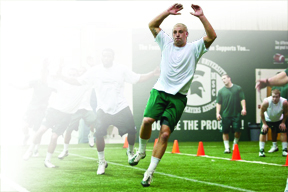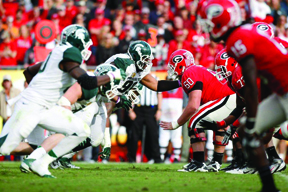Powerline: Exploring neck-up response training
First step explosion, instinctive change of direction (COD) and swift response to visual and pressure cues are vital athletic attributes sought after by coaches of all sports. The approaches, equipment and protocols implemented for training these components are broad scoped with varying degrees of efficacy and time efficiency.
For this Powerline installment, let’s step out of the weight room and sit down in the classroom for some key teaching points on developing movement skills, functional quickness and response time.
First on the docket are the correct procedures for demonstrating movements — whether they’re strength training exercises, speed and agility mechanics, or position-specific skills.The art & science of demonstration
Demonstration is the most common means of communicating skill performance. Good demonstrations, performed with a live model or through the use of video, require some thoughtful planning. The reason is quite simple: Incorrect demonstrations can be detrimental instead of helpful.
Research (Magill, 2004) indicates that there are three key elements involved in giving purposeful demonstrations: Attention, facilitative memory and coaching feedback.
Attention
A coach must begin the process by pre-planning the key points of the demonstration and making sure the environment is conducive to learning. All of the athletes are placed in the best possible viewing position for the demo, with the skill being viewed from the angle at which the athlete executes it.
If it’s a complex skill, demonstrate it from several angles with a slow motion demo always being followed by a full-speed one, thus enabling the athletes to perceive the difficulty of the movement.
The coach also makes sure to focus only on the key points of the movement, as the average person has a limited capacity to acquire and store meaningful information on a new task (Schmidt, 2004). Coaches must be wary of overloading athletes with initial information, especially if it isn’t critical to the successful execution of the skill.
As a rule of thumb, limit the demonstration to two or three crucial points of emphasis and cue in on these elements during the demo. And, direct the athletes’ attention to the most relevant aspects of the skill.
The coach then alternates short periods of practice with the demonstrations. Once the basic aspects of the skill are drilled, the coach identifies the most common mistakes and has them demonstrated by the model. These are then immediately followed with demos of the corrections.
Facilitative memory
For optimal retention, it’s important to have the athletes practice the skill immediately after the demonstration. The practice sequence mirrors the demonstration to maintain the continuity of the teaching progression.

Mental practice can be a tremendous aid in skill retention. Teach the athlete to imagine the skill as vividly as possible (complete with color, environmental conditions, crowd noise, etc.). There is some validity to the age-old coaching axiom of playing the game in your head before you take the field — at least in terms of mental skill practice.
Have the athletes imagine themselves executing the skill in question correctly and successfully. This is done individually or with a group.
When instructing athletes to do this, emphasize three simple guidelines:
1. Have the athletes close their eyes and picture themselves executing the skill with perfection.
2. Ask the athletes to mentally summarize the key points you have taught them for their own benefit.
3. Ask the athletes to then verbally summarize these points, in their proper sequence and with clarity, for you and everyone else in the meeting room.
Mental practice offers several advantages:
- Provides practice of the cognitive and decision-making aspects of the skill.
- Enables athletes to rehearse the possible actions, strategies and probable outcomes of the actual performance.
- Builds confidence for subsequent performance, which allows for effective management of stress and anxiety, which are especially common with young, inexperienced athletes. It also reinforces skill techniquesand serves as a teaching aidfor other members of the team or position group.
Effective use of coaching feedback
Feedback from a knowledgeable coach is crucial in the learning process. Coaches who do not interact with their athletes on a continual basis regarding the correct and incorrect aspects of skill execution severely impair the quality of practice.
This tends to be the case as the competitive season wears on, when both coaches and athletes get absorbed in game strategies at the expense of proper skill practice and fundamentals. The latter deteriorates quickly in this scenario.
Proper feedback motivates athletes to try harder, learn faster and improve on the capabilities to recognize and correct their own mistakes. Make this feedback concise, clear and specific. The most common type of feedback usually revolves around errors and it’s extremely important that it’s delivered in a positive manner.
For instance, in the initial stages of learning a new movement, bring the athlete aside when a mistake is made, show them what was wrong and why it’s wrong, then immediately instruct the correct procedures. Coaches should take care, especially when dealing with young athletes, to enable the learning process instead of harping on the mistake, which only clouds the situation with embarrassment and detracts the focus from the task at hand.
In that same vein, positive feedback on properly performed movements pays huge dividends. We all know that coaching encompasses a lot more than just correcting mistakes. It also must include rewarding and encouraging athletes for performing well and executing with great effort.
Some argue that point with, “That is what they are supposed to do!” True, but put yourself in the athletes position: What if every yearly evaluation by your supervisor included only what you were doing wrong along with suggestions for correcting unacceptable behavior?
I am sure you get the point.
Coaches should be liberal with encouraging statements and positive rewards when they are truly earned by the athletes. A simple pat on the back, a smile, a friendly nod or a way to go, does wonders in improving self-esteem and performance, especially with really young, inexperienced athletes. It also helps beginners enjoy what they are doing and having fun is an integral part of maintaining interest in a sport or a skill.
Developing quick responders
What we often refer to as explosiveness is just as much a matter of great response time as it is a physical attribute. The term response time tends to be used interchangeably and erroneously with reaction time. Here’s a clarification.
Reaction time (as defined in the motor learning literature) is the interval of time between the onset of a signal (i.e., stimulus) and the initiation of a response. It’s important to note that reaction time does not include the movement itself but only the time prior to the beginning of the movement.

The term movement time is used to define the interval of time between the initiation and completion of the movement.
Response time encompasses the total time interval represented by both reaction time and movement time.
One can correctly surmise that improvement in response time involves an upgrade in reaction time, movement time or both. This is accomplished with a four-pronged approach:
1. Reduce the number of stimulus-response choices. As mentioned earlier, the average person has a limited ability to acquire, store and use meaningful information in learning-specific tasks. The wise coach focuses on teaching the most prominent aspects of the skill very well, as opposed to delivering myriad techniques and options that have a very low percentage of use potential. Simply put, focus on the vitals of the skill/task and allow the athletes to master those before overloading them with second- and third-level information.
2. Search for predictors. You often hear experienced athletes say they were in a zone or the game has slowed down for them. What’s actually happening in many cases is they have become adept at recognizing predictors of the response possibilities before them, which is predicated on narrowing down the opponent’s intentions. This is achieved after hours of video study and mental and physical practice.
In other words, your athletes should be able to use the short time they have to recognize visual or pressure cues more efficiently in preparing for an appropriate response. They have a heightened level of anticipation for what is about to unfold because it’s stored in their memories. This is why we study video so intently and then practice responding successfully to the predictors we identify.
3. Design quality, task-specific practices. Once the best responses are defined for the situations to be faced, the players are drilled on the correct cues they receive and done so at game-like tempo. Game situations offer the paramount component of specificity — more so than most watered-down individual or group periods offer.
Proper practice reduces uncertainty in situations involving unfamiliar stimuli or extremely complex tasks. If the players are not presented with the big picture in practice, they have difficulty responding when it’s flying at them at a frenetic pace in the game.
Most game situations require athletes to adjust their techniques to cues while they are on the move. The motor learning literature refers to this variability as forced-paced actions and these add tremendously to the difficulty of both the teaching and learning processes. To get the desired results, coaches are obligated to practice under these anticipated game conditions.
This includes crowd noise. Here at Michigan State, we introduce crowd noise during team periods at almost every practice, including those for home game preparation.
4. Insure an optimal arousal level. We are speaking here of an emotional mind-setan intangible product of motivation. Emotions certainly play an important role in performance, but coaches should know that emotions only carry you so far in a contest. And, without adequate preparation, they’re meaningless.
Emotions should gradually build up during the course of game week and never overshadow proper preparation in strategy and schemes. Emotions flow easier and are much more sincere when the team is entering the game with a high confidence level due to knowing exactly what to do under all circumstances.
Final rep
As we have mentioned in past columns on skill development, once your teaching approach and strategy are determined, remember to remain true to the Principle of Specificity, which states that the more the practice context mirrors the game context, the more correct and skilled the responses are when they really count.
Ken Mannie is the head strength and conditioning coach Michigan State University. His column, Powerline, appears regularly in Coach & Athletic Director magazine.
Suggested readings:
Magill, R., 2004, Motor Learning: Concepts and Applications, 7th ed., McGraw Hill Publishers, New York, NY.
Schmidt, R., Wrisberg, C.A., 2004, Motor learning and Performance: A Problem-Based Approach, 3rd ed., Human Kinetics, Champaign, IL.


